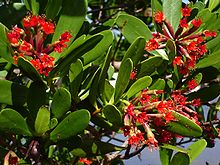
Back Mirtagtiges Afrikaans آسيات Arabic آسيات (رتبه من النباتات) ARZ Myrtales AST Mərsinçiçəklilər Azerbaijani Myrtales BCL Міртакветныя Byelorussian Міртакветныя BE-X-OLD Миртоцветни Bulgarian Myrtales BS
| Myrtales Temporal range:
| |
|---|---|

| |
| Lumnitzera littorea | |
| Scientific classification | |
| Kingdom: | Plantae |
| Clade: | Tracheophytes |
| Clade: | Angiosperms |
| Clade: | Eudicots |
| Clade: | Rosids |
| Clade: | Malvids |
| Order: | Myrtales Juss. ex Bercht. & J.Presl[2] |
| Families | |

The Myrtales are an order of flowering plants (angiosperms) placed as a sister to the eurosids II clade as of the publishing of the Eucalyptus grandis genome in June 2014.[3]
The APG III system of classification for angiosperms still places it within the eurosids; this is corroborated by the placement of the Myrtales in the Malvid clade by the One Thousand Plant Transcriptomes Initiative.[4] The following families are included as of APG III:[2]
- Alzateaceae S. A. Graham
- Combretaceae R. Br. (leadwood family)
- Crypteroniaceae A. DC.
- Lythraceae J. St.-Hil. (loosestrife and pomegranate family)
- Melastomataceae Juss. (including Memecylaceae DC.)
- Myrtaceae Juss. (myrtle family; including Heteropyxidaceae Engl. & Gilg, Psiloxylaceae Croizat)
- Onagraceae Juss. (evening primrose and Fuchsia family)
- Penaeaceae Sweet ex Guill. (including Oliniaceae Arn., Rhynchocalycaceae L. A. S. Johnson & B. G. Briggs)
- Vochysiaceae A. St.-Hil.
The Cronquist system gives essentially the same composition, except the Vochysiaceae are removed to the order Polygalales, and the Thymelaeaceae are included. The families Sonneratiaceae, Trapaceae, and Punicaceae are removed from the Lythraceae. In the classification system of Dahlgren the Myrtales were in the superorder Myrtiflorae (also called Myrtanae). The APG III system agrees with the older Cronquist circumscriptions of treating Psiloxylaceae and Heteropyxidaceae within Myrtaceae, and Memecyclaceae within Melastomataceae.
Ellagitannins are reported in dicotyledoneous angiosperms, and notably in species in the order Myrtales.[5]
- ^ "Myrtales". www.mobot.org. Retrieved 2023-07-20.
- ^ a b Angiosperm Phylogeny Group (2009), "An update of the Angiosperm Phylogeny Group classification for the orders and families of flowering plants: APG III", Botanical Journal of the Linnean Society, 161 (2): 105–121, doi:10.1111/j.1095-8339.2009.00996.x, hdl:10654/18083
- ^ Myburg AA, Grattapaglia D, Tuskan GA, Hellsten U, Hayes RD, Grimwood J, et al. (June 2014). "The genome of Eucalyptus grandis" (PDF). Nature. 510 (7505): 356–62. Bibcode:2014Natur.510..356M. doi:10.1038/nature13308. PMID 24919147. S2CID 4392576.
- ^ Leebens-Mack JH, Barker MS, Carpenter EJ, Deyholos MK, Gitzendanner MA, Graham SW, et al. (One Thousand Plant Transcriptomes Initiative) (October 2019). "One thousand plant transcriptomes and the phylogenomics of green plants". Nature. 574 (7780): 679–685. doi:10.1038/s41586-019-1693-2. PMC 6872490. PMID 31645766.
- ^ Yoshida T, Amakura Y, Yoshimura M (January 2010). "Structural features and biological properties of ellagitannins in some plant families of the order Myrtales". International Journal of Molecular Sciences. 11 (1): 79–106. doi:10.3390/ijms11010079. PMC 2820991. PMID 20162003.